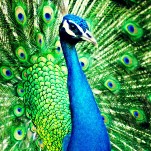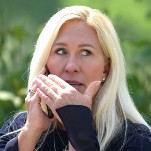How the Kardashians Replaced the Windsors and Became the Royal Family of the 2010s
LatestIn this pop cultural moment utterly owned by the sprawling Kardashian family, so compelling in its weirdly flat drama, it’s easy to forget that once upon a time, actual royals—specifically, the House of Windsor and their endless drama—dominated the media.
In the period between Diana Spencer’s appearance on the scene as love interest to Prince Charles and the immense outpouring over her horrible 1997 death in Paris, the British royal family was a near-weekly staple. It wasn’t just in the tabs, either, though sharp-elbowed tabloid reporters in Britain were early to note that something had gone awry with the royal romance and would make scandalous hay out of every new development over the following years, with their American counterparts eventually enthusiastically piling on as well.
But newspapers and general interest publications also covered the story in loving detail—if fairly straight—as it morphed from romance to character-driven trainwreck of massive public interest. Women’s magazines like McCall’s and Women’s Day and Ladies’ Home Journal first bought into the fairy tale, before shifting to a stance of concern and consolation.
It’s easy to forget just how much they had to write about. As a foursome, Charles, Diana, Camilla, and the Queen were perfectly capable of spawning a storyline on par with Liz Taylor’s marriages or Jennifer Aniston’s supposed loneliness, something that could boost circulation for years.
Then there was Fergie and Andrew, too, adding that Khloé/Kourtney/Scott Disick tier, which in turn established the critical mass necessary to make anyone associated with Windsors worth at least a mention. Consider the intro to a 1994 People magazine piece on a scandalous tell-all about Princess Margaret, Queen Elizabeth’s younger sister: “With Princess Diana in semiretirement and the Duchess of York under wraps, the royal family has been without a Scandal Queen to amuse the masses. No longer, however.” For a while, the magazine ran a recurring feature called “Royal Watch,” which once published this entry about Prince Edward, currently best known as the one nobody ever remembers:
Ever since Prince Edward lost his job as a theater production assistant last month, senior courtiers at Buckingham Palace have been making discreet inquiries in hopes of finding meaningful employment for the queen’s youngest son. Now the Daily Telegraph speculates that Edward, 27, may join the British Broadcasting Corporation—but in what capacity, no one knows. A suitable post, offered the Telegraph, may be “a backstage job as an apprentice in the arts department.” Perhaps. But it’s clear that Edward, who last month played an English nobleman in the Aberdeen Theatre’s production of Macbeth, prefers center stage.
Scandal wasn’t new for the royal family, of course. There were the wild days of Victoria’s son Prince Edward and his Marlborough House Set; there was Margaret, who first tried to marry a divorced man then ended up with a photographer, whom she eventually divorced. And of course, it was a breathtaking scandal that landed Elizabeth’s father (and therefore eventually Elizabeth herself) on the throne in the first place, when Edward VIII dipped out to marry the shockingly unsuitable Wallis Simpson. The British media had closely tracked Prince Charles’s romantic life.
But like Joan Collins’s addition to the Dynasty cast in Season 2, it was Diana’s arrival at the precise right moment that took the show to the next level. Her and Charles’ “love story” was tailor-made for a backlash era obsessed with the doings of the rich. She was a soft-voiced beauty presented as sweet, impossibly young, impeccably virginal. She’d worked in the stereotypically feminine position of part-time kindergarten teacher but promptly gave it up. She quickly produced two very cute children. But then the obvious plotlines had been exhausted and the cracks in the foundation became apparent, and it became another sort of backlash narrative—one of marriage run off the rails. Which in turn provided the frame for any other scandalous doings. Fergie caught appearing to get her toes sucked? Well, that’s the Windsors for you.
Meanwhile, the media was developing into the modern infotainment business which would make the 1995 O.J. Simpson trial such an inflection point in American popular culture. (As well as foreshadowing the rise of the Kardashians.) And so you couldn’t so much as run out for Tide and a bag of potato chips without bumping into this messy family’s latest shenanigans.
Then Diana died. There was a very real feeling that the paparazzi and the media generally had somehow contributed to her death, thereby implicating everybody who’d ever bought a tabloid with the People’s Princess’s face on it. There was one final, enormous outpouring of grief, which frankly seemed to burn everybody out, other than macabre diehards. And what had been a perennial storyline trailed off. Fergie, God bless her, could only generate so much interest. The boys were too young. Charles and Camilla married and settled into a quiet middle age that made them seem less scandalous, more endearing. Queen Elizabeth II kept making public appearances where nothing much happened.
-

-

-

-

-

-

-

-

-

-

-

-

-

-

-

-

-

-

-

-

-

-

-

-

-

-

-

-

-

-

-

-

-

-

-

-

-

-

-

-








































